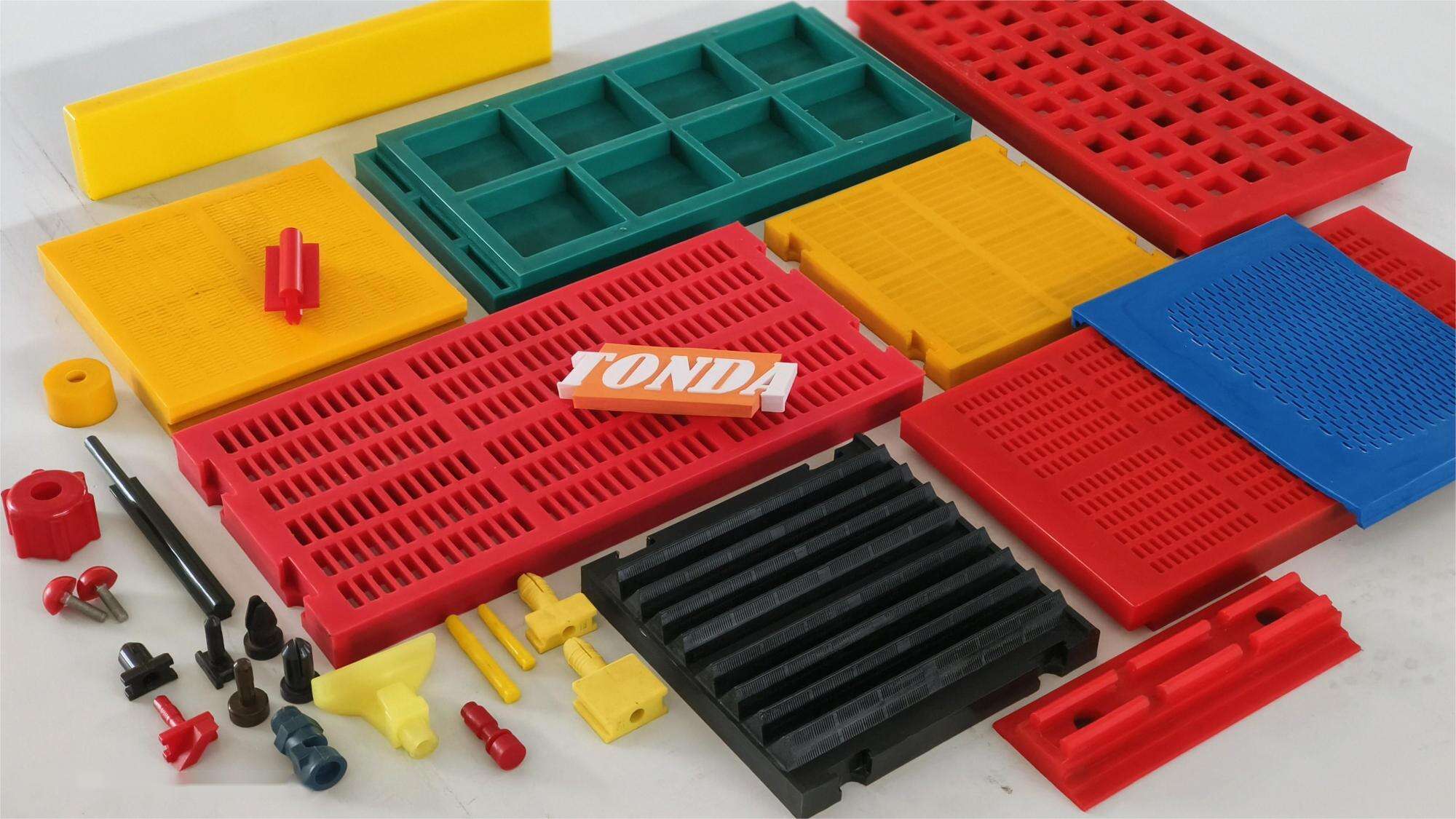Why Tension Is Critical for Polyurethane Screen Media
When polyurethane screen media is properly tensioned, it can withstand those intense vibrations and impacts from materials passing through. If the tension isn't right though, something happens to those screen apertures. The openings get messed up, which messes with how well the screening actually works. According to research published last year by mining professionals, there's quite a difference between good tension and bad. Screens that are properly tightened retain about 93% of particles where they should be, while ones that are slack only manage around 76%. That gap matters a lot when talking about operational efficiency in processing plants.
Mechanics of Tension Distribution in Flex-Mat Polyurethane Systems
Today's polyurethane screens are built with multidirectional load distribution systems that stop stress from building up in one spot. The flex-mat design actually works by directing vibration energy across those reinforced rib structures, which means these screens last about 2.5 times longer before showing signs of fatigue compared to standard models without this structural reinforcement. A study published back in 2022 looked at how different tension levels affect performance. They found that when tension drops below 12 Newtons per square millimeter, materials tend to separate unevenly during processing. But push that tension past 18 N/mm² and things start breaking down faster at the clamp areas where components connect. This kind of insight helps engineers fine tune their equipment setups for optimal longevity.
Uniform Tension Strategies to Prevent Edge Wear and Deformation
Edge failures account for 65% of premature screen replacements in fine mineral processing. Modular tensioning systems with progressive clamping force adjusters reduce edge stress by 40% compared to single-bolt designs, as demonstrated in a North American iron ore plant case study[^1^]. Key strategies include:
- Pre-tension calibration to ±2% tolerance during installation
- Real-time strain gauges for load monitoring during operation
[^1^]: Installation best practices for tensioned polyurethane screens
Consequences of Improper Tension on Screening Efficiency and Lifespan
Under-tensioned screens experience 3× faster aperture elongation, causing particle misclassification in sub-100 µm streams. Over-tensioning reduces polyurethane’s natural vibration dampening, increasing fracture risks by 28% (SME, 2023). Both scenarios shorten replacement cycles from 12–18 months to 6–9 months, significantly raising operational costs.
Over-Tensioning vs. Under-Tensioning: Finding the Balance for Fine Particles
For mineral feeds measuring around -0.5 mm, keeping tension somewhere between 15 and 22 kN per square meter works best, finding that sweet spot where materials stay flexible yet firm enough. Research from Purdue back in 2019 showed that when screens operate within these parameters, they cut down on pegging issues by about 37 percent, all while holding onto nearly 98% of their usual throughput capacity. The real game changer comes with dynamic tension adjustments that respond to changes in feed density throughout operation. These adaptive methods can actually boost equipment lifespan by approximately 19%, something highlighted in those top tier vibration control manuals that many plants follow religiously.
Flexibility, Vibration Absorption, and Clog Resistance in Tensioned Systems
How Tension Enhances Flexibility and Dampens Vibrations
When properly tensioned, polyurethane screen media becomes something special - a surface that actually works because it's both flexible and strong at the same time. The difference between this material and regular rigid screens is pretty significant. Tensioned polyurethane can bend sideways about 18 to 24 percent more than standard options according to recent findings from Materials Today in 2023. This extra give lets the material soak up impacts without messing up the shape of the openings in the screen. What really matters for folks working in mineral processing plants though is how much less vibration there is. Studies show around 30 to 40 percent fewer vibrations when screens are properly tensioned, which means less wear and tear on all the equipment further down the line. A paper published last year in Advanced Engineering Materials looked into this too. They found that certain tension patterns actually create areas where energy gets absorbed specifically, kind of like what happens with those expensive industrial rubber parts but without losing any precision in the screening process itself.
Tension-Induced Oscillation: Preventing Particle Lodging in Fine Screening
When properly tensioned, surfaces create oscillations between about 400 to 800 cycles each minute. This creates a cleaning action that helps shake loose particles down to around 1.5 mm in size. Some tests run at a copper processing plant in Canada found that screens stayed clear 27% more often when using well-tensioned polyurethane materials compared to traditional woven wire options. The tiny movements work kind of like those vibration dampening systems seen in high precision equipment, breaking the grip that particles have on surfaces with carefully timed mechanical nudges throughout operation.
Reducing Aperture Clogging Through Dynamic Surface Movement
Tensioned polyurethane screens resist clogging via three synergistic mechanisms:
- Lateral Stretch Recovery – 92% shape memory retention after deformation (vs. 68% in non-tensioned screens)
- Radial Contraction – 0.2–0.5 mm aperture size fluctuation during operation
- Surface Wave Propagation – Standing waves with 12–18 mm amplitude
This dynamic behavior allows 98% of near-aperture-sized particles (within ±0.3 mm) to escape screening pockets, compared to 74% in static systems. These movements are linked to a 34% reduction in maintenance costs for operations processing high-clay-content ores.
Polyurethane vs. Woven Wire Screen Media: A Performance Comparison
Vibration Response and Separation Efficiency: Key Differences
Polyurethane works really well in places where there's a lot of vibration because it can handle those mechanical movements without breaking down structurally. The material's elasticity lets each opening vibrate on its own, so particles don't get stuck as much. According to research from Haverniagara back in 2023, this actually makes the separation process about 22% more accurate. When looking at how materials pass through, polyurethane gets over 94% throughput for particles smaller than 2 mm. That's way better than the 78% we see with regular woven wire screens in lab tests. Some companies are now making hybrid versions that mix polyurethane with extra strong tension wires. These combinations boost throughput by around 40% compared to old fashioned woven screens. Plus they help cut down on unwanted vibrations thanks to their natural damping properties.
Advantages of Tensioned Polyurethane Over Traditional Woven Wire
Modern tensioned polyurethane systems overcome key limitations of woven wire:
- Wear Resistance: Tension-optimized polyurethane lasts 5× longer than woven wire in abrasive coal screening applications.
- Clog Mitigation: Independent wire movement reduces pegging incidents by 67% through continuous aperture reshaping.
- Energy Efficiency: Lower mass reduces deck load by 18%, cutting power consumption by 1.2 kWh per ton processed.
With 35% greater open area than woven equivalents, polyurethane enhances fine mineral recovery without sacrificing durability.
Case Study: Efficiency Gains in a Real-World Mineral Processing Plant
A midwestern iron ore facility replaced woven wire screens with tension-calibrated polyurethane panels, achieving measurable improvements:
| Metric | Woven Wire Baseline | Polyurethane Result |
|---|---|---|
| Screen Lifespan | 42 days | 287 days |
| Downtime/Repairs | 14 hours/month | 3 hours/month |
| <2mm Fines Recovery | 81% | 93% |
The plant reduced media replacement costs by $18,000 monthly while improving yield consistency across moisture levels from 5% to 17%.
Installation and Maintenance Best Practices for Long-Term Reliability
Ensuring Correct Installation and Routine Inspection to Maintain Tension
Getting proper tension right begins with having properly calibrated tools and following good alignment procedures. When bolts are over tightened, they create stress points that speed up edge wear problems. On the flip side, if something isn't tight enough it leads to slippage issues and can distort the aperture shape over time. According to recent studies in industrial fastening practices from last year, most technicians find that applying around 20 to maybe 30 Newton meters of torque works best when tightening components in a radial pattern one after another. After installation is complete, maintenance crews should check the tension levels roughly every 200 hours of operation. They typically use laser deflection measurements for this task, looking out for any changes that go beyond plus or minus 5 percent compared to what was measured initially during setup.
Matching Tension Levels to Feed Material Characteristics
Fine-particle screening (≤2 mm) requires 10–15% higher baseline tension to counteract lodging forces, while abrasive ores benefit from 5–7% lower tension to accommodate flexing.
| Material Type | Ideal Tension Range | Adjustment Frequency |
|---|---|---|
| Fine Particles | 0.22–0.25 kN/m | Every 150 hours |
| Coarse Gravel | 0.18–0.20 kN/m | Every 300 hours |
| High-Abrasion Ores | 0.15–0.17 kN/m | Every 75 hours |
Operations aligning tension settings with material hardness and granulometry reduced media replacement costs by 38% annually, according to a 2023 Industrial Minerals Association study.
Frequently Asked Questions
What is polyurethane screen media?
Polyurethane screen media is a type of screening surface made from polyurethane material, known for its flexibility, durability, and ability to absorb vibrations.
Why is tension important for polyurethane screen media?
Proper tension is crucial as it ensures that the screen apertures maintain their shape, leading to improved screening efficiency and a longer lifespan for the screen media.
How does improper tension affect screening efficiency?
Improper tension can lead to faster aperture elongation, particle misclassification, and increased fracture risks, all of which reduce the efficiency of the screening process.
What are the advantages of tensioned polyurethane over traditional woven wire?
Tensioned polyurethane offers better wear resistance, clog mitigation, and energy efficiency compared to traditional woven wire screens.
How often should tension levels be checked?
Tension levels should be checked every 200 hours of operation to ensure proper performance and prevent premature wear and tear.
Table of Contents
- Why Tension Is Critical for Polyurethane Screen Media
- Mechanics of Tension Distribution in Flex-Mat Polyurethane Systems
- Uniform Tension Strategies to Prevent Edge Wear and Deformation
- Consequences of Improper Tension on Screening Efficiency and Lifespan
- Over-Tensioning vs. Under-Tensioning: Finding the Balance for Fine Particles
- Flexibility, Vibration Absorption, and Clog Resistance in Tensioned Systems
- Polyurethane vs. Woven Wire Screen Media: A Performance Comparison
- Vibration Response and Separation Efficiency: Key Differences
- Advantages of Tensioned Polyurethane Over Traditional Woven Wire
- Case Study: Efficiency Gains in a Real-World Mineral Processing Plant
- Installation and Maintenance Best Practices for Long-Term Reliability
- Frequently Asked Questions

